

The Chronology of Modern Art. Waking from the American Dream. Edward Hopper, Night Hawks, 1942 I sit in one of the dives On Fifty-second Street Uncertain and afraid As the clever hopes expire Of a low dishonest decade:(W H Auden, September 1st 1939) The “low dishonest decade” Auden refers to was the 1930s, which was the high point of the American art movement known as Precisionism, or sometimes cubist realism.
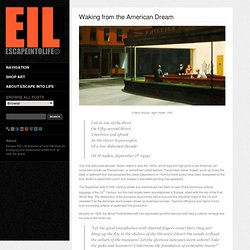
The phrase “clever hopes” sums up nicely the state of optimism that had preceded the Great Depression of 1929 but must surely have been dissipated by the time Auden’s pessimistic poem and Hopper’s alienated painting had appeared. Charles Sheeler (1883 - 1965) Artwork Images, Exhibitions, Reviews. The Photography of Charles Sheeler: American Modernist. Editor's note: The Georgia O'Keeffe Museum provided source material to Resource Library for the following article.
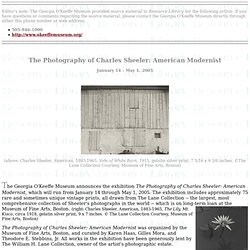
If you have questions or comments regarding the source material, please contact the Georgia O'Keeffe Museum directly through either this phone number or web address: Charles Sheeler: Across Media - Photography. Sheeler was trained at the School of Industrial Art in Philadelphia from 1900 to 1902.
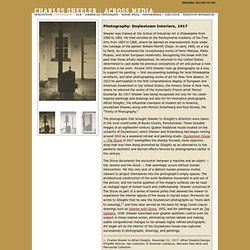
He then enrolled at the Pennsylvania Academy of the Fine Arts from 1903 to 1906, where he learned an impressionistic style under the tutelage of the painter William Merritt Chase. In early 1909, on a trip to Paris, he encountered the revolutionary works of Henri Matisse, Pablo Picasso, and other European modernists. Recognizing the break with the past that these artists represented, he returned to the United States determined to cast aside his previous conceptions of art and pursue a new direction in his work. Around 1910 Sheeler took up photography as a way to support his painting — first documenting buildings for local Philadelphia architects, and later photographing works of art for New York dealers.
The photographs that brought Sheeler to Stieglitz's attention were taken in the rural countryside of Bucks County, Pennsylvania. 1. The Precisionist Movement - The City Paintings of Edward Hopper, Charles Sheeler and Georgia O'Keeffe. As a son of an executive of a steamer company, Charles Sheeler (1883-1965) began his very first art classes at the School of Industrial Art in Philadelphia.
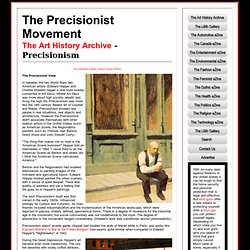
After applying a number of times to the Pennsylvania Academy of the Fine Arts, he finally accepted in 1903. There he studied under William Merritt Chase, who helped cultivate Sheeler’s early painterly style. After graduation in 1906, he and his fellow artist, Morton Schamberg, began to experiment with photography which was used to support their paintings. He experienced the new trends in modern art through Cezanne, Picasso, Braque, and Matisse during a trip to Paris in 1908. Goodspeed Update » Blog Archive » The Meaning of Charles Sheeler. Posted: May 7th, 2006 | Author: Rob Goodspeed | Filed under: Art, District of Columbia | Comments Off I’m pretty excited about a small exhibit of works by Charles Sheeler that opened today at the National Gallery.
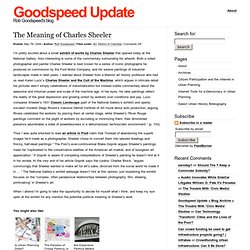
Also interesting is some of the commentary surrounding his artwork. Both a noted photographer and painter Charles Sheeler is best known for a series of iconic photographs he produced on commission by the Ford Motor Company, and his serene paintings of industrial landscapes made in later years. Specific Object: Charles Sheeler. Charles Sheeler. Charles Sheeler. Charles Sheeler. "The ungainly name "Precisionism" was coined by the painter-photographer Charles Sheeler, mainly to denote what he himself did.

It indicated both style and subject. As Avant Garde as the Rest of Them: An Introduction to the Armory Show. Even before the Armory Show opened, organizers and more than a few journalists described the exhibition as an invasion of modern art on America.

In the New York Times and Sun, headlines like "It Will Throw a Bomb Into Our Art World and a Good Many Leaders Will be Hit" and "Cubist, Futurists, and Post Impressionists Win First Engagement, Leaving the Enemy Awestruck" greeted the public, emphasizing the paintings of Duchamp, Matisse, and Picabia and the sculpture of Brancusi as intellectual warfare. The Chicago Record-Herald announced an equally resounding battle cry of "Advance Guard Arrives" when the show moved from New York to Chicago in March 1913.
Charles Sheeler: Across Media. Charles Sheeler. (American, 1883-1965) 8,541 Artists and 51,682 Works Online SaveNot on view White Barn, Bucks County, Pennsylvania 1914-17 SaveNot on view Bucks County Barn 1914-17 SaveNot on view Stairwell 1914-17 SaveNot on view Doylestown House, Stairway, Open Door 1914-17 SaveNot on view Barn 1917 SaveNot on view African Negro Mask 1917-18 SaveNot on view African Sculpture 1917-18 SaveNot on view Barn Abstraction 1918 SaveNot on view Tulips and Etruscan Vase 1922 SaveNot on view Self-Portrait 1923 SaveNot on view Yachts 1924 SaveNot on view Delmonico Building 1926 SaveNot on view Criss-Crossed Conveyors, River Rouge Plant, Ford... 1927 SaveNot on view Bleeder Stacks, Ford Plant, Detroit 1927 SaveNot on view Ford Plant, River Rouge, Blast Furnace and Dust...

Charles Sheeler: Across Media. Doylestown House—Stairs from Below. Charles sheeler & photgraphic myth. Books: Charles Sheeler: Across Media (Hardcover) by Charles Brock (Author) and Charles Sheeler (Author) Charles Sheeler: Across Media - Commercial Photography. During the 1920s Sheeler found success and recognition as a commercial photographer.
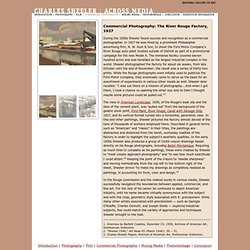
In 1927 he was hired by a prominent Philadelphia advertising firm, N. W. Ayer & Son, to shoot the Ford Motor Company's River Rouge auto plant located outside of Detroit as part of a promotional campaign for the new Model A. The immense facility covered eleven hundred acres and was heralded as the largest industrial complex in the world.
Andrew Smith Gallery - Lee Friedlander - Sticks and Stones. The Andrew Smith Gallery opens an exhibit of new photographs titled STICKS AND STONES: ARCHITECTURAL AMERICA by the American master LEE FRIEDLANDER on July 8, 2005.
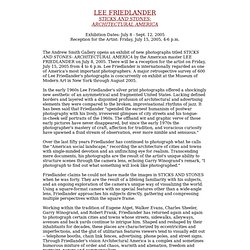
There will be a reception for the artist on Friday, July 15, 2005 from 4 to 6 p.m. Lee Friedlander is internationally regarded as one of America's most important photographers. A major retrospective survey of 600 of Lee Friedlander's photographs is concurrently on exhibit at the Museum of Modern Art in New York through August 2005. In the early 1960s Lee Friedlander's silver print photographs offered a shockingly new aesthetic of an asymmetrical and fragmented United States. Web 2.0 Tools YOU can USE in Education. 2nd Laziest to Straight-A: How to Transform to a Productive and Superstar Student.
How and When Prototyping Practices Affect Design Performance. Khan Academy.